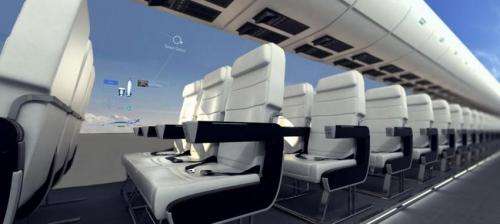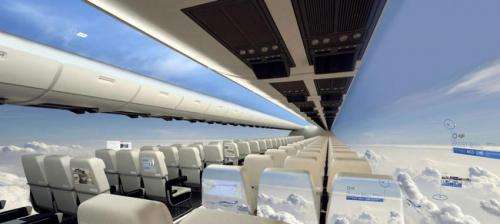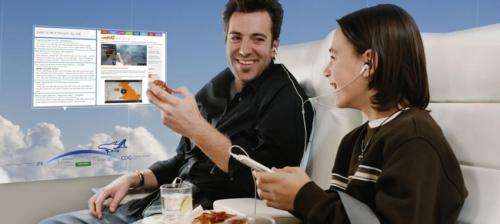October 30, 2014 weblog
Future air passengers may get unique, windowless view

A windowless airplane sounds like a claustrophobic nightmare. A windowless airplane with OLED displays, aura-enhanced with subtle cabin lighting from gently glowing walls could be quite something else. Using OLED (organic light emitting diode) technology, thin, bendable, lightweight display screens would blend with the fuselage and surfaces, such as seatbacks. Use of this concept would optimize space and reduce the weight of the aircraft.
The Center for Process Innovation (CPI) dares to consider this as a sign of the future in air travel. Weight reduction is a constant challenge, said CPI. OLED displays replacing windows could bring significant benefits. "Imagine a cabin where the windows are display screens, relaying a choice of views from around the aircraft. If you're not sitting in a window seat, your large seat-back display becomes your window on the world as well as a source of entertainment." As such, the CPI vision is that of display technologies that could line the interior walls of cabins and display live footage from external cameras. Open your eyes more than ever, said a CPI video, to reduced cost, lighter and stronger fuselage, wider seating, lower fuel consumption. The screens are thin, light and flexible enough to be integrated with the fuselage or seatbacks, removing the need for heavy housings.
Over 80 percent of the fully laden weight of a commercial airliner is the aircraft itself and its fuel. For every 1 percent reduction in weight, the approximate fuel saving is 0.75 percent. If you save weight, you save fuel, said CPI. And less fuel means less CO2 emissions into the atmosphere and lower operational cost.
CPI is doing more than working up visions; they said they are working with companies to develop flexible OLED technologies for the aerospace industry. Lightweight printed wiring looms can provide multiple conductors for security. Their concept involves individual display panels "seamlessly" arranged along the cabin walls. A multi-screen approach means panels can be used either as displays or for lighting, depending upon the cabin seating layout and seat pitches.
"Internal tracking cameras could be used to project the image onto the screen from the point of view of the passenger- moving the image in accordance with the movements of the passenger's head." Users in any seat can select views from any side of the aircraft. It would not be necessary to reflect the actual view seen from a particular seat; the cameras could be mounted in the most aerodynamically efficient positions on the aircraft.
Wouldn't such a system and its lighting be confusing, though, over long-distance flights where the passenger would want to know the difference between night and day? CPI has a plan for that too. The lighting panels would allow the color changes associated with sunrise and sunset, helping long-haul passengers adjust to different time zones.

According to CPI, "Using roll to roll manufacturing techniques that are currently in development at CPI, these screens could be produced at a cost that is unlikely to be any more than current displays."
In August, CPI's Dr. Simon Ogier, research and development manager, said: "Our role is to turn innovative technology concepts such as OLED displays into manufactured products. Work has so far focused on the back layer and the flexibility and performance of Organic Thin Film Transistor arrays (OTFTs), which operate a screen's individual pixels to form the picture." He also said "Now we know we can tightly bend these parts and maintain function, the challenge is to combine this with an equally flexible front layer for a fully flexible, high performance display."

The Center for Process Innovation is a UK-based technology innovation center. Design Week reported Monday that CPI is looking to work with designers and the aerospace industry to realize the windowless planes. "CPI is looking to make flexible screens featuring flexible OLEDs and is looking for design partners to take the idea forward."
More information: www.uk-cpi.com/windowless-fuselage/#.VFIERx3F_Sb
© 2014 Tech Xplore





















